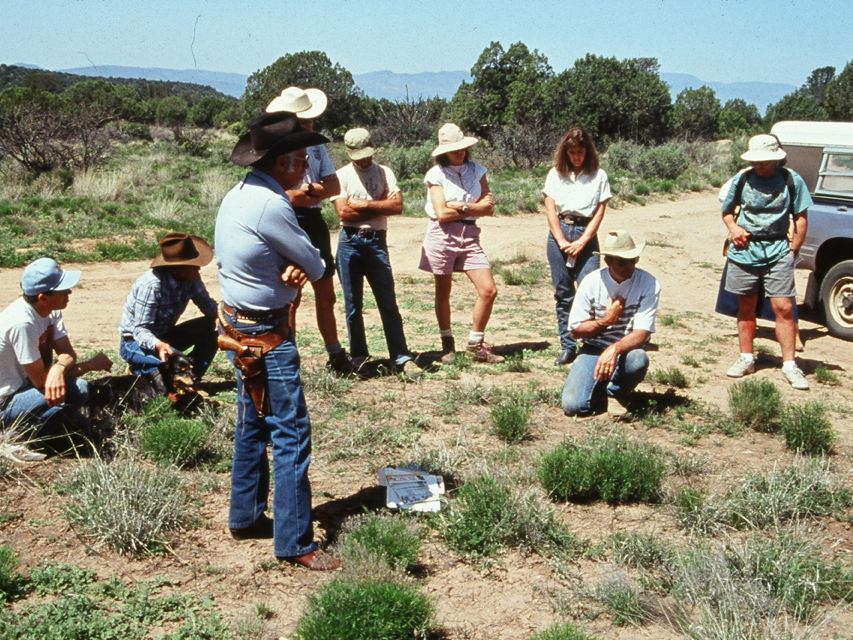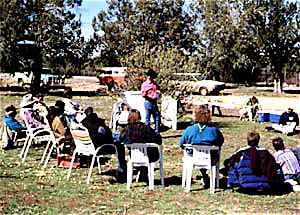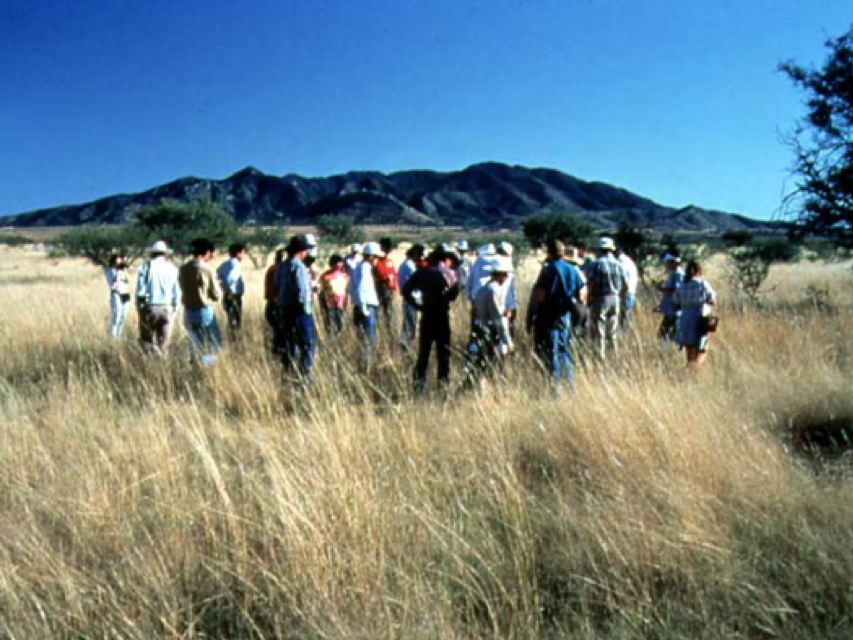
You’ve heard it a million times. You’ve probably said it yourself…
If we could just stop fighting and work together, things would be so much easier. There would be so much less hate and strife and arguing……
Or, why don’t politicians compromise? Then they wouldn’t just be fighting all the time and wasting our money doing it. Instead Democrats blame the Republicans for not compromising. The Republicans blame the Democrats for refusing to work together, yadda, yadda, yadda.
LOWERING THE HEAT OF BATTLE
I thought I had found the holy grail of ”working together” in the contentious area of environmental politics some years ago when I attended a meeting, in Phoenix, Arizona, of ranchers and environmentalists dealing with the issue of predators, livestock, and ”predator control.” (You can’t get much more contentious than that.)
At the time of this get-together everyone who attended was involved, in one way or another, in a controversy over the Arizona law that governed what ranchers could do to protect their livestock from natural predators such as mountain lions and black bears. This battle had become so contentious that one of the activists involved, a woman who had made the reintroduction of Mexican gray wolves into the Southwest her life work, became fearful that the battle would so galvanize ranchers against environmentalists that wolf reintroduction would be jeopardized. That’s why she and a friend from a ranching family had called this meeting. To see if anything could be done to lower the heat of battle.

HEY, THAT’S WHAT I WANT, TOO!
What was to be different about this meeting was that it was to be conducted according to the principles of ”conflict resolution.” One of the women (the one from the ranch family) was self-schooled in this sort of facilitation. Her approach, which is familiar to most of us today, was totally new to most of us (me, for sure) at the time. Briefly, It consisted of helping those of us from both sides of our predatory divide to discover that we want the same things — healthy ecosystems, a sustainable lifestyle, clean air, clean water, etc., — after which, the theory goes, we would stop fighting and join forces to work together to achieve these shared goals.
The teambuilding went surprisingly well. Those of us on the environmental side were surprised to hear ranchers adding goals that we thought only we cared about — sustainable open space, sustainably plentiful populations of wildlife… One rancher even said, ”Healthy populations of predators.” but another qualified his statement with, ”Maybe not too healthy.”
GOALS THAT UNITE, GOALS THAT INCITE
This Kowboy Kumbaya was made possible by a simple but powerful process implemented by our facilitator.: Whenever one of us would list as one of our goals a policy rather than a result, i. e. whenever one of us would say something like: ”I want all the cows off public lands!” or ”I want all streams protected from grazing!” she would ask us what we would like to achieve by doing that. How would we expect that move to change the land? How would it look? How would the rangeland ecosystem be better? And she would keep asking questions like this until we answered in terms of ends instead of means — There’d be more plants and less bare dirt. Less nonnatives. More wildlife.
Some of the ranchers offered policies as goals, too — fewer regulations, more freedom — and they got the same treatment: How would the land look if they got what they wanted? How would it be better?
LIBERALISM AS AN OBSTACLE TO COLLABORATION
The reason she did this is because she knew we all agreed on ends, we all wanted healthy rangelands, functional watersheds, lots of wildlife (Who doesn’t?). But she also knew we had been fighting over means — preservation versus production, grazing versus protection — for nearly a century. What she was doing was calculated to keep us from going down that same old road.
Those of you who have read posts in this blog in which I observe that liberals identify the solution to any problem as the imposition of a liberal policy will recognize why she picked the approach she picked.
By steering our discussion from means to ends, from what we wanted to do to what we wanted our environment to be, our facilitator was creating a liberalism-free zone; and she was doing this precisely because she recognized that without creating a zone free of the assumption that the solution to any problem is the imposition of some policy or other collaboration is impossible.
In other words whether our facilitator knew it or not, she was affirming that liberalism stands as an obstacle to collaboration, to working together. Why is that?
If someone firmly believes the solution to any problem is the imposition of a specific policy, then it becomes impossible to ”meet in the middle?” What middle? For liberals there is no middle, there is only, ”My way or the highway.” Or more accurately, ”The liberal way or the highway.”
NOTICE THE ”WE.”
If, on the other hand, two factions, no matter how politically opposed, are able to get past all the ”My way or the highway” talk to admit to themselves, and to one another, that they all want healthy ecosystems, functional watersheds, plenty of wildlife, clean water, clear air, then the next question is, ”How do we achieve it?”
Notice the ”we?”
MORE POWERFUL THAN VICTORY
Those of us in our group realized the importance of this when we moved our meetings from locations in Phoenix to the lands of some of our rancher participants. On those desert rangelands we found that the ranchers among us were already achieving the goals we supposedly ”co-discovered” in those facilitated meetings. In fact, all of the ranches we visited were healthier and more ecologically functional than the cattle-free preserves I, as a committed environmentalist, was working to create. From that I concluded that working together 6-6 style could be more powerful than victory for our side.

Our group expanded and continued to meet and learn, and we gave ourselves a name: The 6-6 Group (for 6 of us and 6 of them that attended that first meeting). While I was experiencing this, and watching it work, what we were doing seemed momentous, even paradigm-shifting, for several reasons: First, the problems the ranchers in our group were succeeding in dealing with were not mere tokens. They were problems the environmental movement has been railing against (and failing against) for more than a century — desertification, the deterioration of watersheds, endangered species, invasive plants, the urbanization of open space, etc.
Second, these solutions were being achieved in the spirit of teamwork, collaboration, cooperation, community, peace, love, etc.. That’s what liberals are all about, right? There was no confrontation, lawsuits, demonstrations, divisive politics, or people chaining themselves to trees. What could be more Kumbaya than that?
A KUMBAYA END TO A HUNDRED YEARS WAR
How out of the ordinary was this? Ranchers and environmentalists have been at odds at least since John Muir, the founder of the Sierra Club tried to stop grazing in the California Sierras in the late 1900s. Billions have been spent by both sides. Much bad blood has been created. Some real blood has even been spilled. What I had stumbled onto seemed to be a way to end this hundred year range war, and who knows what other disputes it might solve environmental and otherwise.
READ IT AND SEE IT
I was so impressed with what we were learning, both about the land and about working together, that I wrote a book about it — Beyond the Rangeland Conflict, Toward a West that Works, As a result of the success of that book, and because the ideal of working together is so seductive to both sides, I became a speaker in high demand. For more than a decade speaking engagements came looking for me, and I took the story of 6-6 around the West to a whole spectrum of audiences — environmentalists, ranchers, vegetarians, beef producers, college classes, garden clubs, and just plain folks.
Some of the stories I brought to these audiences included:
“¢ A ranch family in Nevada and a rancher in Arizona who developed the process of using cattle to restore ecosystem function and a healthy plant community to devastated mine sites on which standard reclamation practices had failed.
“¢ A New Mexico rancher who stewarded the ranch he managed to such a state of ecological health that it was more attractive to nesting songbirds, including one endangered species, than two adjacent preserves, one of which was called ”The Bird Area.” This ranch (not the preserve) was found to host the highest known density of nesting songbirds in North America.
“¢ A regular host to 6-6 meetings who liked to show off his ranch because it was obviously in better shape than an adjacent preserve owned by a major environmental group.
Consider, again (because it’s so important) that these successes were achieved without fighting, without ”victory,” without acrimony (except for a little gloating — well deserved I might add.). Isn’t this what all those people who display ”Coexist” bumper stickers and wear ”Peace” t-shirts claim to want. It is certainly what liberal politicians have said they want and promised they will achieve.
NO SALE
That’s why I really didn’t think this was going to be a hard sell, especially to other environmentalists.
But it was. In fact, it was almost impossible.
To make my case about this new collaborative method, I showed my environmental colleagues dramatic ”before and after” photos and side-by-side comparisons, took them to the sites, even completed demonstration projects to prove that it wasn’t smoke and mirrors. In spite of all that, the majority of them weren’t enthused or optimistic or even curious. Instead they became uncomfortable, defensive, some even became angry. ”I feel like I’m being attacked,” more than one of my environmental audience members said.
At first I was puzzled by this response. I questioned whether I was presenting the material effectively, or whether the successes I was reporting were as outstanding as I thought. But I was getting positive feedback on my presentations, too, and I was getting plenty of requests for more presentations, so I was pretty sure neither of the above was the problem.
I even began to wonder if environmentalists really care about the environment, but that didn’t seem to make any sense. The people I was talking to seemed to care so much and so honestly about trees and birds and open space that accusing them of not ”really” caring didn’t make any sense. So, I gave that up too, at least until I learned that it was true in a way I had never understood before.
THE MADNESS IS IN THE MESSAGE
Finally, after years of frustration puzzling over why this method that seemed to hold such promise never really ”took off”, I was the one who finally got the message. I came to the conclusion that environmentalists’ lack of interest in the 6-6 approach wasn’t because it didn’t work or because it wasn’t being described effectively. It was because of something environmentalists don’t know about their movement or even about themselves.
Search the environmental universe on the internet and you’ll find all sorts of claims about what we absolutely MUST! do in order to save the planet. You’ll find sites claiming that, in order to keep from destroying the environment, we have to impact nature less by using less, producing less, and reproducing less. We have to stop eating meat, destroy capitalism, reduce economic growth, end America’s consumerism, reduce the number of humans on the planet (in some cases by incredibly cruel means such as epidemics, war, eugenics, suicide…,) And, not only that, we have to base our lifestyles, economic system, spirituality, selection of leaders, even the way we choose to die, on the same.
That’s why my presentations about the 6-6 method left so many environmentalists uninterested, angry or feeling threatened. First, because the successes of 6-6 proved that the practices contemporary environmentalists insist are absolutely necessary if we are to solve our environmental problems really aren’t necessary at all. In fact, 6-6 brought to light a whole list of instances in which applying those liberal remedies not only didn’t solve the problem, they made it worse.
Beyond that, 6-6 revealed that there is a means to restore and sustain the health of the environment that doesn’t villainize capitalism or America’s unprecedented economic success, doesn’t involve confrontations, lawsuits or divisive politics, and doesn’t require the election of ecofacist politicians to whom we must relinquish our freedoms, from the most public to the most private, from the most trivial to the most momentous.
And the great majority of contemporary liberal environmentalists faced with that choice rejected it.
WHY THEY REJECTED IT…
When liberal environmentalists found themselves in the situation of being presented with with an effective way to solve environmental problems that inspired opposing factions to work together but that didn’t succeed because of liberal policies, and in some cases succeeded in spite of them, they revealed their true priorities. They chose to maintain their allegiance to the liberal policies even though it was now clear that those policies caused some of the very problems they are purported to solve.
To put it another way, for contemporary liberal environmentalists, the environment is the means and enacting liberal policies is the end. It is not the other way around.
So, it appears we don’t really have groups working to achieve positive, concrete environmental goals as things now stand. What we do have is a number of liberal political groups that use environmental issues, both real and manufactured, to sell liberal policies and liberal candidates. By so doing, they increase their control over government and the rest of us while they make money, grow their power and prestige, consider themselves world saviors, do a lot of self-backpatting, etc. In other words, environmentalism is an economic endeavor just like any other economic endeavor —mining, ranching, lobbying, lawyering, politicking, and, just like those other economic endeavors, it has environmental, social, and economic impacts, in many cases worse than the impacts of the groups the liberals allege to protect us from.
WILL THE REAL ENVIRONMENTALISTS PLEASE STAND
But what about those of us who really want to deal with the environment in a functional, accountable way? I know there are plenty of us out here who want to solve its problems, resolve its issues, realize its opportunities, and achieve goals which most of us share. And there are plenty of us who would rather do it by working together where possible and competing where appropriate.
The successes achieved by 6-6 and groups like it reveal that the best way to achieve what I just described is via the workings of conservatism — applying individual initiative, personal accountability, the free market, and rewards for results. Applying this approach automatically puts us on course to work toward concrete goals by means of which we can gauge our effectiveness and recognize our shared interests, and that works whether you’re liberal or conservative.
So why aren’t there lots of conservative environmental groups out there satisfying this very real demand that they are most qualified to satisfy?
The answer (the subject of the next post) will surprise you.





